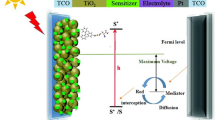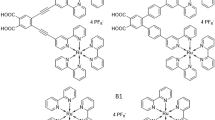Abstract
Iridium complexes with dicyanovinyl-grafted phenylpyridine/1-phenylisoquinoline as ligands are synthesized and their photophysical, electrochemical, and sensitization properties in DSSCs are investigated. The iridium complexes present significantly enhanced absorption from 400 to 525 nm. The 1-phenylisoquinoline-based iridium complex show bathochromic-shift emission in DMSO solution compared with their phenylpyridine-based counterpart, while their absorption response and photoluminescence peak in solid show little difference despite extension of the conjugated system. Using DSSCs, the conversion efficiency of 0.62% and open-circuit current of 1.4 mA/cm2 is achieved. The poor performance is attributed to the excited-state properties of iridium complexes according to the TD-DFT calculation.
Similar content being viewed by others
References
Lamansky S, Djurovich P, Murphy D, Abdel-Razzaq F, Lee HE, Adachi C, Buttows PE, Forrest SR, Thompson ME. Highly phosphorescent bis-cyclometalated iridium complexes: synthesis, photophysical characterization, and use in organic light emitting diodes. J Am Chem Soc, 2001, 123: 4304–4312
Nazeeruddin MK, Humphry-Baker R, Berner D, Rivier S, Zuppiroli L, Graetzel M. Highly phos phorescence iridium complexes and their application in organic light-emitting devices. J Am Chem Soc, 2003, 125: 8790–8797
Kim J, Shin IS, Kim H, Lee JK. Efficient electrogenerated chemiluminescence from cyclometalated iridium(III) complexes. J Am Chem Soc, 2005, 127: 1614–1615
Lee SJ, Park KM, Yang KY, Kang YJ. Blue phosphorescent Ir(III) complex with high color purity: fac-tris(2′,6′-difluoro-2,3′-bipyridinato-N,C 4′)iridium(III). Irorg Chem, 2009, 48: 1030–1037
Chiu YC, Hung JY, Chi Y, Chen CC, Chang CH, Wu CC, Cheng YM, Yu YC, Lee GH, Chou PT. En route to high external quantum efficiency (∼12%), organic true-blue-light-emitting diodes employing novel design of iridium(III) phosphors. Adv Mater, 2009, 21: 2221–2225
Seo HJ, Yoo KM, Song MK, Park JS, Jin SH, Kim YI, Kim JJ. Deep-blue phosphorescent iridium complexes with picolinic acid N-oxide as the ancillary ligand for high efficiency organic light-emitting diodes. Org Electron, 2010, 11: 564–572
Yuan YY, Zhang JY, Yu ZT, Feng JY, Lou WJ, Ye JH, Zou ZG. Impact of ligand modification on hydrogen photogeneration and light-harvesting applications using cyclometalated iridium complexes. Inorg Chem, 2012, 51: 4123–4133
Lo KKW, Hui WK, Chung CK, Tsang KHK, Lee TKM, Li CK, Lau JSY, Ng DCM. Luminescent transition metal complex biotin conjugates. Coord Chem Rev, 2006, 250: 1724–1736
Lo KKW, Chung CK, Lee TKM, Lui LK, Tsang KHK, Zhu N. New Luminescent cyclometalated iridium(III) diimine complexes as biological labeling reagents. Inorg Chem, 2003, 42: 6886–6897
Lo KKW, Ng DCM, Chung CK. First examples of luminescent cyclometalated iridium(III) complexes as labeling reagents for biological substrates. Organometallics, 2001, 20: 4999–5001
Chen H, Zhao Q, Wu Y, Li F, Yang H, Yi T, Huang C. Selective phosphorescence chemosensor for homocysteine based on an iridium(III) complex. Inorg Chem, 2007, 46: 11075–11081
Tam AYY, Tsang DPK, Chan MY, Zhu NY, Yam VWW. A luminescent cyclometalated platinum(II) complex and its green organic light emitting device with high device performance. Chem Commun, 2011, 47: 3383–3385
Buda M, Kalyuzhny G, Bard AJ. Thin-film solid-state electroluminescent devices based on tris(2,2′-bipyridine) ruthenium(II) complexes. J Am Chem Soc, 2002, 124: 6090–6098
Cheng YM, Yeh YS, Ho ML, Chou PT. Dual room-temperature fluorescent and phosphorescent emission in 8-quinolinolate osmium(II) carbonyl complexes: rationalization and generalization of intersystem crossing dynamics. Inorg Chem, 2005, 44: 4594
Lee SJ, Park JS, Song MK, Shin IA, Kim YI, Lee JW, Kang JW, Gal YS, Kang SW, Lee JY, Jung SH, Kim HS, Chae MY, Jin SH. Synthesis and characterization of red-emitting iridium(III) complexes for solution-processable phosphorescent organic light-emitting diodes. Adv Funct Mater, 2009, 19: 2205–2212
Baranoff E, Yum JH, Graetzel M, Nazeeruddin MK. Cyclometallated iridium complexes for conversion of light into electricity and electricity into light. J Organometal Chem, 2009, 694: 2661–2670
Shinpuku Y, Inui F, Nakai M, Nakabayashi Y. Synthesis and characterization of novel cyclometalated iridium(III) complexes for nanocrystalline TiO2-based dye-sensitized solar cells. J Photochem Photobio A: Chem, 2011, 222: 203–209
Mayo EI, Kilsa K, Tirrell T, Djurovich PI, Tamayo A, Thompson ME, Lewis NS, Gray HB. Cyclometalated iridium(III)-sensitized titanium dioxide solar cells. Photoch Photobio Sci, 2006, 5: 871–873
Schwartz KR, Chitta RH, Bohnsack JN, Ceckanowicz DJ, Miró P, Cramer CJ, Mann KR. Effect of axially projected oligothiophene pendants and nitro-functionalized diimine ligands on the lowest excited state in cationic Ir(III) bis-cyclometalates. Inorg Chem, 2012, 51: 5082–5094
Yan QF, Fan YP, Zhao DH. Unusual temperature-dependent photophysics of oligofluorene-substituted tris-cyclometalated iridium complexes. Macromolecules, 2012, 45: 133–141
Sun JF, Wu WH, Guo HM, Zhao JZ. Visible-light harvesting with cyclometalated iridium(III) complexes having long-lived 3IL excited states and their application in triplet-triplet-annihilation based upconversion. Eur J Inorg Chem, 2011: 3165-3173
Hallett AJ, Ward BD, Kariuki BM, Pope SJA. Neutral and cationic cyclometallated Ir(III) complexes of anthra[1,2-d]imidazole-6, 11-dione-derived ligands: syntheses, structures and spectroscopic characterisation. J Organometallic Chem, 2010, 695: 2401–2409
Hallett AJ, White N, Wu WH, Cui XN, Horton PN, Coles SJ, Zhao JZ, Pope SJA. Enhanced photooxidation sensitizers: the first examples of cyclometalated pyrene complexes of iridium(III). Chem Commun, 2012, 48: 10838–10840
Wang DD, Wu Y, Jiao B, Dong H, Zhou GJ, Wang G, Wu ZX. Wide tuning of emission color of iridium(III) complexes from green to deep red via dicyanovinyl substituent effect on 2-phenylpyridine ligands. Org Electron, 2013, 14: 2233–2242
Ito S, Murakami TN, Comte P, Liska P, Grätzel C, Nazeeruddin MK, Grätzel M. Fabrication of thin film dye sensitized solar cells with solar to electric power conversion efficiency over 10%. Thin Solid Films, 2008, 516: 4613–4619
Neve F, La Deda M, Crispini A, Bellusci A, Puntoriero F, Campagna S. cationic cyclometalated iridium luminophores: photophysical, redox, and structural characterization. Organometallics, 2004, 23: 5856–5863
Tamayo AB, Garon S, Sajoto T, Djurovich PI, Tsyba IM, Bau R, Thompson ME. Cationic bis-cyclometalated iridium(III) diimine complexes and their use in efficient blue, green, and red electroluminescent devices. Inorg Chem, 2005, 44: 8723–8732
Wang ZS, Kawauchi H, Kashima T, Arakawa H. Significant influence of TiO2 photoelectrode morphology on the energy conversion efficiency of N719 dye-sensitized solar cell. Coord Chem Rev, 2004, 248: 1381–1389
Ning Z, Zhang Q, Wu W, Tian H. Novel iridium complex with carboxyl pyridyl ligand for dye-sensitized solar cells: high fluorescence intensity, high electron injection efficiency? J Organomet Chem, 2009, 694: 2705–2711
Kuang DB, Ito S, Wenger B, Klein C, Moser JE, Humphry-Baker R, Zakeeruddin SM, Gratzel M. High molar extinction coefficient heteroleptic ruthenium complexes for thin film dye-sensitized solar cells. J Am Chem Soc, 2006, 128: 4146–4154
Author information
Authors and Affiliations
Corresponding author
Electronic supplementary material
Rights and permissions
About this article
Cite this article
Wang, D., Dong, H., Zhang, X. et al. Dicyanovinyl-unit-induced absorption enhancement of iridium(III) complexes in long-wavelength range and potential application in dye-sensitized solar cells. Sci. China Chem. 58, 658–665 (2015). https://doi.org/10.1007/s11426-014-5212-x
Received:
Accepted:
Published:
Issue Date:
DOI: https://doi.org/10.1007/s11426-014-5212-x




